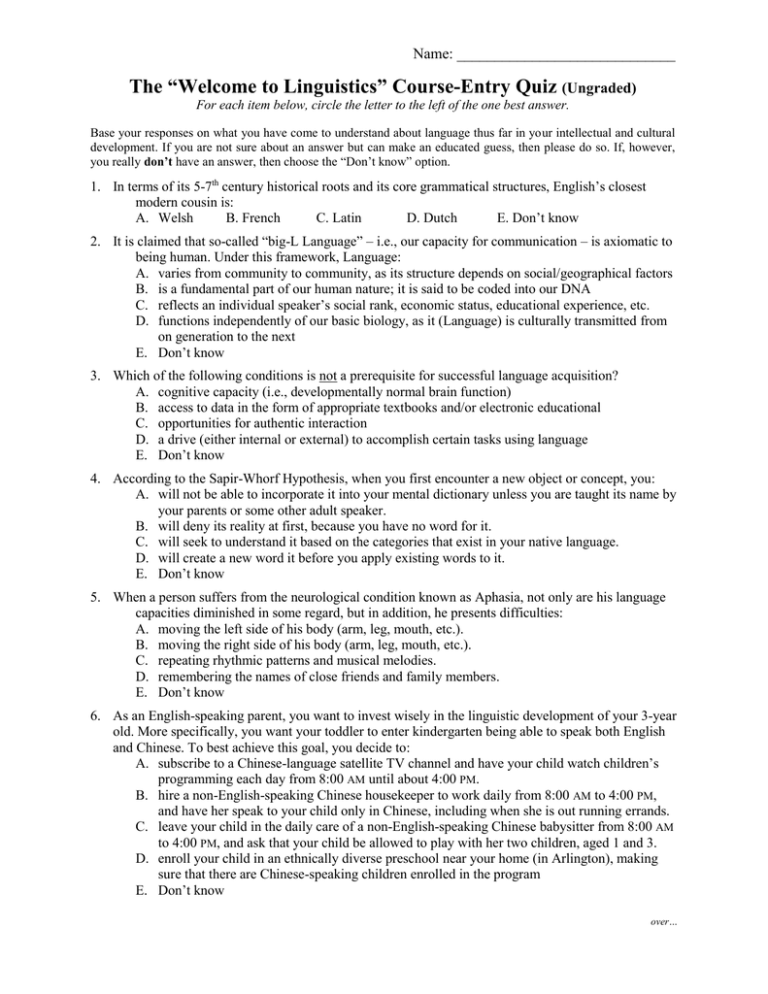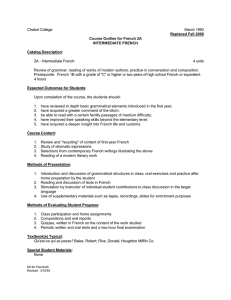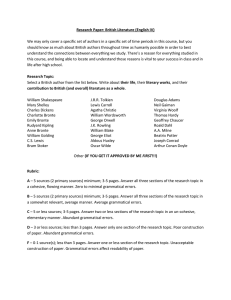The “Welcome to Linguistics” Course-Entry Quiz Name: _____________________________ (Ungraded)
advertisement

Name: _____________________________ The “Welcome to Linguistics” Course-Entry Quiz (Ungraded) For each item below, circle the letter to the left of the one best answer. Base your responses on what you have come to understand about language thus far in your intellectual and cultural development. If you are not sure about an answer but can make an educated guess, then please do so. If, however, you really don’t have an answer, then choose the “Don’t know” option. 1. In terms of its 5-7th century historical roots and its core grammatical structures, English’s closest modern cousin is: A. Welsh B. French C. Latin D. Dutch E. Don’t know 2. It is claimed that so-called “big-L Language” – i.e., our capacity for communication – is axiomatic to being human. Under this framework, Language: A. varies from community to community, as its structure depends on social/geographical factors B. is a fundamental part of our human nature; it is said to be coded into our DNA C. reflects an individual speaker’s social rank, economic status, educational experience, etc. D. functions independently of our basic biology, as it (Language) is culturally transmitted from on generation to the next E. Don’t know 3. Which of the following conditions is not a prerequisite for successful language acquisition? A. cognitive capacity (i.e., developmentally normal brain function) B. access to data in the form of appropriate textbooks and/or electronic educational C. opportunities for authentic interaction D. a drive (either internal or external) to accomplish certain tasks using language E. Don’t know 4. According to the Sapir-Whorf Hypothesis, when you first encounter a new object or concept, you: A. will not be able to incorporate it into your mental dictionary unless you are taught its name by your parents or some other adult speaker. B. will deny its reality at first, because you have no word for it. C. will seek to understand it based on the categories that exist in your native language. D. will create a new word it before you apply existing words to it. E. Don’t know 5. When a person suffers from the neurological condition known as Aphasia, not only are his language capacities diminished in some regard, but in addition, he presents difficulties: A. moving the left side of his body (arm, leg, mouth, etc.). B. moving the right side of his body (arm, leg, mouth, etc.). C. repeating rhythmic patterns and musical melodies. D. remembering the names of close friends and family members. E. Don’t know 6. As an English-speaking parent, you want to invest wisely in the linguistic development of your 3-year old. More specifically, you want your toddler to enter kindergarten being able to speak both English and Chinese. To best achieve this goal, you decide to: A. subscribe to a Chinese-language satellite TV channel and have your child watch children’s programming each day from 8:00 AM until about 4:00 PM. B. hire a non-English-speaking Chinese housekeeper to work daily from 8:00 AM to 4:00 PM, and have her speak to your child only in Chinese, including when she is out running errands. C. leave your child in the daily care of a non-English-speaking Chinese babysitter from 8:00 AM to 4:00 PM, and ask that your child be allowed to play with her two children, aged 1 and 3. D. enroll your child in an ethnically diverse preschool near your home (in Arlington), making sure that there are Chinese-speaking children enrolled in the program E. Don’t know over… 7. Which of the following situations is not true in the world today? A. There are languages that are spoken in more than one nation. B. There are nations in which multiple languages are spoken. C. There are cases in which two (or more) nations claim the what is linguistically the same language, but refer to it by different names (and, perhaps, employ different writing systems). D. Every nation specifies which language(s) are official within its borders. E. Don’t know 8. Imagine the year is 1800. In which of the following situations are the languages of community “A” and community “B” most likely to be the same (or at least highly similar)? A. when A is in Europe and B is in North America B. when A is on the east side of mountain range and B is on the west, five miles away from A C. when A is on the coast and B is located on an island five miles off the coast D. when A is upstream along a river and B is five miles downstream along the same river E. Don’t know 9. In all communicative signs (including, but not limited to linguistic signs), one observes: A. form and meaning B. form, meaning, and function C. form, meaning, function, and arbitrariness D. form, meaning, and arbitrariness E. Don’t know 10. Consider this bit of language: While hiking, Jack planned to carefully catalogue all the plants that he came across. This sentence is: A. prescriptively grammatical AND descriptively grammatical B. prescriptively grammatical BUT descriptively ungrammatical C. prescriptively ungrammatical BUT descriptively grammatical D. semantically ill-formed because of the dangling preposition, across E. Don’t know 11. From the perspective of a linguist, when somebody speaks a DIALECT, we know for sure that s/he is: A. less well educated than most other people in his/her home country. B. less logical than most other people in his/her home country. C. from a particular location in his/her home country. D. a member of a non-dominant racial or ethnic group in his/her home country. E. Don’t know 12. When two communities encounter each other, they have been known to communicate by: A. adopting a mixed system, one that incorporates elements of both of their languages B. opting to use a third “outside” language C. having one of the groups use the other group’s language D. (A) and (B) and (C) E. Don’t know



